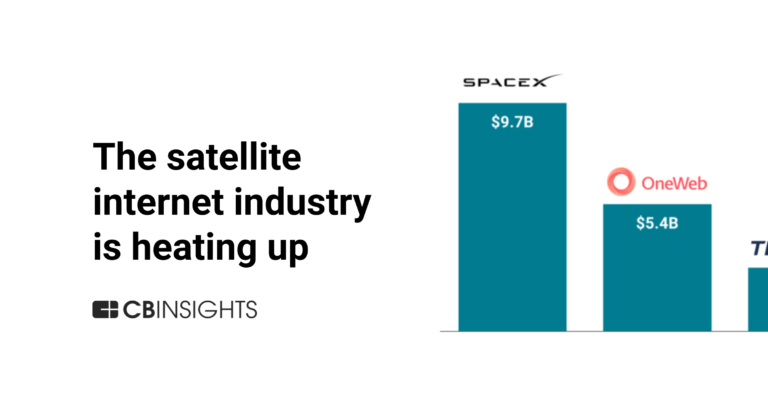
Astranis
Founded Year
2015Stage
Series D | AliveTotal Raised
$762.57MLast Raised
$200M | 3 mos agoMosaic Score The Mosaic Score is an algorithm that measures the overall financial health and market potential of private companies.
+35 points in the past 30 days
About Astranis
Astranis specializes in the development of small, low telecommunications satellites within the aerospace industry. The company's main offerings include the creation of spacecraft designed for geostationary orbit, and providing broadband internet services to underserved populations globally. Astranis primarily serves the telecommunications sector, delivering bandwidth-as-a-service to commercial and government entities. It was founded in 2015 and is based in San Francisco, California.
Loading...
ESPs containing Astranis
The ESP matrix leverages data and analyst insight to identify and rank leading companies in a given technology landscape.
The satellite internet service providers (ISPs) market offers a compelling solution for customers who require reliable and accessible internet connectivity in areas where traditional terrestrial networks are limited or unavailable. By utilizing a network of satellites orbiting the earth, satellite ISPs offer a global reach, enabling connectivity in remote locations, rural areas, and even on moving…
Astranis named as Challenger among 11 other companies, including Viasat, Iridium Communications, and SpaceX.
Loading...
Research containing Astranis
Get data-driven expert analysis from the CB Insights Intelligence Unit.
CB Insights Intelligence Analysts have mentioned Astranis in 1 CB Insights research brief, most recently on Jun 6, 2023.
Expert Collections containing Astranis
Expert Collections are analyst-curated lists that highlight the companies you need to know in the most important technology spaces.
Astranis is included in 3 Expert Collections, including Unicorns- Billion Dollar Startups.
Unicorns- Billion Dollar Startups
1,249 items
Sales & Customer Service Tech
600 items
Companies offering technology-driven solutions to enable, facilitate, and improve customer service across industries. This includes solutions pre-, during, and post-purchase of goods and services.
Aerospace & Space Tech
3,437 items
These companies provide a variety of solutions, ranging from industrial drones to electrical vertical takeoff vehicles, space launch systems to satellites, and everything in between
Astranis Patents
Astranis has filed 5 patents.
The 3 most popular patent topics include:
- satellite broadcasting
- communications satellites
- network topology

Application Date | Grant Date | Title | Related Topics | Status |
|---|---|---|---|---|
6/12/2023 | 6/11/2024 | Satellite broadcasting, Radio frequency antenna types, Communications satellites, Antennas (radio), Network topology | Grant |
Application Date | 6/12/2023 |
|---|---|
Grant Date | 6/11/2024 |
Title | |
Related Topics | Satellite broadcasting, Radio frequency antenna types, Communications satellites, Antennas (radio), Network topology |
Status | Grant |
Latest Astranis News
Oct 4, 2024
Astranis CEO Talks 2024’s Largest US Space Funding Round Sign up for our Flagship Daily Newsletter Sign Up You are now subscribed to our list. Be sure to add us to your contacts, so we don’t end up in your spam folder! Astranis announced a $200M Series D round this week—the largest US venture raise for a space company thus far in 2024, according to public reports and data assembled by Space Capital, which also ranked the company as the seventh-largest private space infrastructure firm at its reported 2023 valuation of $1.6B. Now, the GEO satellite operator is funded to build nine of its current model satellites in the next two years and complete the development of a new, more capable satellite called Omega, expected to be ready for launch in 2026. Payload caught up with CEO John Gedmark to learn more about the deal. This transcript has been edited for length and clarity. It’s been a tough couple of years for space companies raising private capital. How did you convince investors like Andreesen Horowitz and BAM Elevate to make this bet on your business? We have a pretty incredible roster of customers for satellite projects around the world. We have also started an inflection point with our business with the US government—we’re in prime position here to provide communication services for the armed forces overseas. It all adds up to being in a pretty good position as a company. No single silver bullet there—it’s just a collection of a lot of great execution by the team on many fronts. What makes your firm different from others building low-cost satellites? [In GEO,] your satellites are just taking massive doses of radiation all the time. It is a next level challenge compared to LEO. So we have spent a lot of time and energy and developed a lot of expertise around designing electronics that can do that and that are still very low cost. This capital is going to help scale your satellite factory to produce up to 24 satellites a year. How do you do that in San Francisco? We are very proud to call San Francisco, CA our home for manufacturing. This is the single densest collection of engineering talent in the entire world. That is both hardware and software, and the software piece is really important, right? These satellites are software defined—something that we knew would be key from day one was having the flexibility of being software defined and we knew that this was the right location for us. What we realized in looking across some other companies that have really done things in a new way in the last few years, are the benefits of having your engineering teams and your manufacturing and production teams all under one roof. Then you have these super fast iteration cycles where you can have somebody see something on the production line, or a design engineer spot something while they’re at their desk, and they can just walk down to the factory floor in an instant. How are you managing the transition to the new Omega spacecraft? You have to be able to walk and chew gum at the same time. We wouldn’t be doing it if there was a huge amount of overlap [between the two spacecraft]. The rare thing is…when a specific upgrade is ready, meaning the next version of the hardware is fully tested, qualified, we can roll that into a block of satellites that’s coming off the production line. Or we can bundle up a whole bunch of those improvements and say, it’s the right time to draw a line here, move to a whole new version of the satellite, [and] start a new production line. You also said that no other country can develop GEO satellites at this price, which no doubt stands out in Washington. It is very important that we be able to achieve resiliency in these important national security space capabilities, and we don’t have that today, right? We have just put up giant satellites that cost hundreds of millions or a billion dollars per satellite, and there’s not very many of them. So those make very tempting targets for adversaries. There’s a better way: you deploy large numbers of small satellites, as long as they’re a low enough cost, and then all of a sudden you have this real resiliency there. And that is the name of the game. It’s resiliency. And the Space Force wants it in every orbit, LEO, MEO, GEO. I think we’re pretty well positioned to help them out in some of the higher orbits As Astranis’ workforce has grown, what are the pain points you see while hiring? We find it particularly challenging to find people on the production side, technicians, machinists. They’re incredibly important skills, people develop these skills over years, and sometimes they can be really hard to find. I do think that is something that I’m hoping we as an industry solve over a longer time frame here, we can get more people to go into these highly skilled jobs. I have to ask—any updates on your next launch on the Falcon 9, which was expected to launch before the end of the year? I will refer you to SpaceX for all Falcon 9 related things; we are getting very close. Share
Astranis Frequently Asked Questions (FAQ)
When was Astranis founded?
Astranis was founded in 2015.
Where is Astranis's headquarters?
Astranis's headquarters is located at 575 20th Street, San Francisco.
What is Astranis's latest funding round?
Astranis's latest funding round is Series D.
How much did Astranis raise?
Astranis raised a total of $762.57M.
Who are the investors of Astranis?
Investors of Astranis include Andreessen Horowitz, BlackRock, Fidelity, Baillie Gifford, Balyasny Asset Management and 35 more.
Who are Astranis's competitors?
Competitors of Astranis include SpaceX.
Loading...
Compare Astranis to Competitors

Interstellar Technologies specializes in space transportation services and is a comprehensive space industry infrastructure provider. The company offers low-cost and convenient services for launching small satellites and has pioneered a vertically integrated rocket-satellite service. Interstellar Technologies primarily serves the space industry, including commercial spaceflight and satellite services. It was founded in 2013 and is based in Hokkaido, Japan.
Perigee Aerospace is an aerospace technology company that specializes in the development and deployment of space technology solutions. It manufactures orbital launch vehicles. Its vehicle is designed to lift small satellites into low-altitude and high-inclination orbits, which are useful for weather, remote sensing, and imaging satellites. It enables space researchers to send necessary payloads into the orbital atmosphere. The company was founded in 2018 and is based in Daejeon, South Korea.
Exos Aerospace specializes in the development of reusable space launch vehicles within the aerospace industry. The company offers commercial spaceflight services with a focus on providing customers with access to space for microgravity experiments and payload deployment. It primarily serves sectors that require suborbital technology demonstrations and research in biological, pharmaceutical, medical, and space manufacturing fields. It was founded in 2014 and is based in Greenville, Texas.
Orbital ATK is a company focused on aerospace and defense, providing systems and services for space-related applications. The company offers a range of products including space launch vehicles, satellite components, and missile defense systems. Orbital ATK serves various sectors including government and commercial space and defense markets. Orbital ATK was formerly known as Orbital ATK. It was founded in 2015 and is based in Dulles, Virginia. Orbital ATK operates as a subsidiary of Northrop Grumman.

Sierra Nevada Corporation provides electronic aerospace and defense systems. It offers communication, navigation, and air traffic management systems, as well as provides intelligence, surveillance, reconnaissance, command, and control products. The company was founded in 1963 and is based in Sparks, Nevada.
Roscosmos provides space flights and cosmonautics programs for the Russian Federation. It is based in Moscow, Russian Federation.
Loading...
